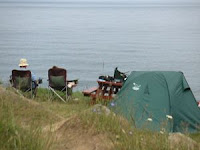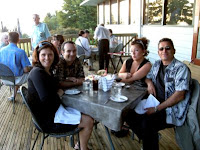 I was a bit surprised to read in the Tourism Daily News, that Cape Breton Island's tourism, one of my favourite places in Canada and one of the most beautiful places in the world is having problems. I understand that there have been challenges for the entire industry in years past, but overall the global numbers released recently indicate that, as a whole, Canadian tourism is strong, mostly because of our domestic tourism.
I was a bit surprised to read in the Tourism Daily News, that Cape Breton Island's tourism, one of my favourite places in Canada and one of the most beautiful places in the world is having problems. I understand that there have been challenges for the entire industry in years past, but overall the global numbers released recently indicate that, as a whole, Canadian tourism is strong, mostly because of our domestic tourism. I have been sa ying for years that Nova Scotia is a prime destination to develop in the Mexican and Spanish markets. As I mentioned in my previous post, the CTC's market research study (September 2007) lists a number of attributes "Mexicans strongly associate with an ideal destination." Let's see how these apply to Cape Breton Island and indeed to all of Nova Scotia:
ying for years that Nova Scotia is a prime destination to develop in the Mexican and Spanish markets. As I mentioned in my previous post, the CTC's market research study (September 2007) lists a number of attributes "Mexicans strongly associate with an ideal destination." Let's see how these apply to Cape Breton Island and indeed to all of Nova Scotia:
 ying for years that Nova Scotia is a prime destination to develop in the Mexican and Spanish markets. As I mentioned in my previous post, the CTC's market research study (September 2007) lists a number of attributes "Mexicans strongly associate with an ideal destination." Let's see how these apply to Cape Breton Island and indeed to all of Nova Scotia:
ying for years that Nova Scotia is a prime destination to develop in the Mexican and Spanish markets. As I mentioned in my previous post, the CTC's market research study (September 2007) lists a number of attributes "Mexicans strongly associate with an ideal destination." Let's see how these apply to Cape Breton Island and indeed to all of Nova Scotia:-
Seeing as much as possible in the time available. Nova Scotia offers a great many number of places to see in a short period of time. Cape Breton itself can be explored in a couple of days seeing great spots like Cheticamp, Pleasant Bay, Meat Cove, Baddeck and many more. Given the average time Mexicans and Spaniards take for vacation, they would have more than enough time to explore in Nova Scotia.
Seeing as much as possible in the time available. Nova Scotia offers a great many number of places to see in a short period of time. Cape Breton itself can be explored in a couple of days seeing great spots like Cheticamp, Pleasant Bay, Meat Cove, Baddeck and many more. Given the average time Mexicans and Spaniards take for vacation, they would have more than enough time to explore in Nova Scotia.
-
Places important in history. If you are interested in Canadian and world history, Nova Scotia is one of the best places to observe and learn. There is living history in Nova Scotia. Of course, Louisbourg is one of the main attractions that Mexican and Spanish tourists would find wonderful, but there is also the Annapolis Valley, Pictou and Halifax itself. So many important events in the history of Canada, France and Great Britain took place in Nova Scotia that anyone interested in history would have a great time learning about them.
Nova Scotia is one of the best places to observe and learn. There is living history in Nova Scotia. Of course, Louisbourg is one of the main attractions that Mexican and Spanish tourists would find wonderful, but there is also the Annapolis Valley, Pictou and Halifax itself. So many important events in the history of Canada, France and Great Britain took place in Nova Scotia that anyone interested in history would have a great time learning about them.
-Places important in history. If you are interested in Canadian and world history,
Great food a nd drink. Seafood anyone? One of my favourite things about Cape Breton and Nova Scotia is the food. Lobster, lobster, lobster. Lobster anyone? Did I mention that Mexicans and Spaniards in general love seafood? Drink? Well, while Nova Scotia is not known for wineries, Mexicans and Spaniards love beer. Perhaps a pint or two of Alexander Keiths would do the trick.
nd drink. Seafood anyone? One of my favourite things about Cape Breton and Nova Scotia is the food. Lobster, lobster, lobster. Lobster anyone? Did I mention that Mexicans and Spaniards in general love seafood? Drink? Well, while Nova Scotia is not known for wineries, Mexicans and Spaniards love beer. Perhaps a pint or two of Alexander Keiths would do the trick.
-
Buying the latest fashions - OK so we can't have it all. In this regard, we can't pretend that Cape Breton or Nova Scotia are fashion centres. Nevertheless, there is some good shopping in Halifax.
Buying the latest fashions - OK so we can't have it all. In this regard, we can't pretend that Cape Breton or Nova Scotia are fashion centres. Nevertheless, there is some good shopping in Halifax.
-
Exciting travel stories. I still have very fond memories of my first (and unfortunately to date) and only trip to Nova Scotia (recall that I was born in Mexico). Undoubtedly, Mexicans would come away with great memories from their time in Cape Breton.
Exciting travel stories. I still have very fond memories of my first (and unfortunately to date) and only trip to Nova Scotia (recall that I was born in Mexico). Undoubtedly, Mexicans would come away with great memories from their time in Cape Breton.
-
A sense of freedom. Anyone who has driven around Cape Breton Island and has stood on the tip of Meat Cove or taken a boat ride to see whales in Pleasant Bay will understand what a sense of freedom one can find in Nova Scotia.
-A sense of freedom. Anyone who has driven around Cape Breton Island and has stood on the tip of Meat Cove or taken a boat ride to see whales in Pleasant Bay will understand what a sense of freedom one can find in Nova Scotia.

I am convinced that Cape Breton is a gem when it comes to its potential in the Mexican and Spanish markets. Of course, no destination is for everyone. Markets must be segmented and the right targets approached. Nova Scotia and Cape Breton are for Mexican and Spanish independent experienced travelers who love to fly and drive and design their own itineraries. Much work needs to be done to develop the markets, but I believe it would be worth it.
-Regards,
Jaime Horwitz MBA
www.nuevaescocia.ca
Share on Facebook

